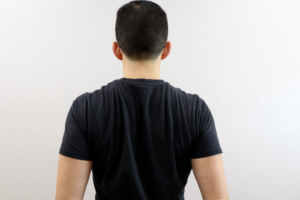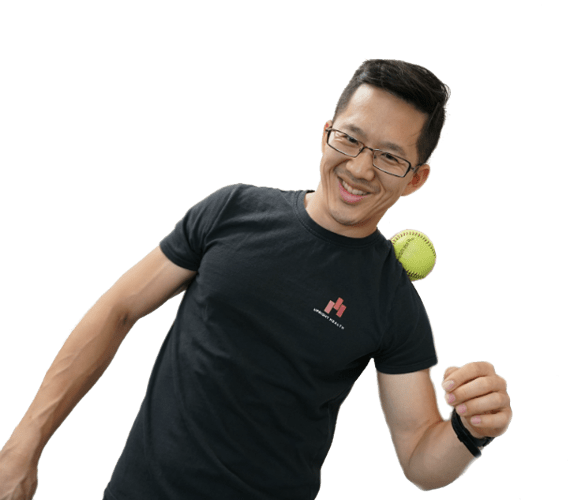Can a labrum generate a pop or snap?
The labrum, as you recall from a few paragraphs ago, is a rubbery disc.
It’s not a hard, stiff object. It’s also tiny and not subject to massive compression when you’re sitting at your computer doing a shrugging motion to test for sound effects.
Based on those two observations alone, we can basically rule it out as being a generator of the clicks and snaps.
In this video, I talk more in detail about snapping and popping in the hips and shoulders and give you a visual explanation of what we just talked about.
Basically, if the labrum is just a soft rubbery disc, it seems highly unlikely that it is responsible for generating popping and snapping. Even if it’s torn and there’s a loose flap, how exactly do we think that this rubbery flap generates audible snapping and popping sounds in the shoulder?
5 Different kinds of shoulder pops and snaps
In my experience pop and snaps can happen all around the shoulder joint and upper back. Funny story: one time, a Rolfer (think of this as a massage therapist who’s obsessed with posture) was working on my chest and anterior shoulder muscles. He snuck his fingers under my pecs and lifted the pec minor up and away from the ribs. There was a loud and audible POP!
We both found it a little disturbing—neither of us having ever heard something so loud come from directly out of a muscle. It felt as if the muscle had been stuck to my rib cage.
This experience and other similar ones make me think pops can also be the result of muscle tissue becoming “unstuck/unglued” from bones or other tendons. Of course I have no way to verify that until I can get my hands on some expensive medical devices or someone else starts doing some medical research on the topic (though, I feel like this should be pretty low on society’s medical research priority list), but there was no way it was a labrum, and there was no way it was from within the shoulder joint! Here are a few of the different places I’ve experienced shoulder pops, clicks, snaps:
1. Front of the shoulder
Sometimes I’ll get one or two loud pops or snaps in the front of the shoulder, near the anterior deltoid and pec major and pec minor attachments. Those are generally louder and have a satisfying sense of tension release. Having experienced this at least hundreds of times, at this point I can tell that this is from muscle tension build up from being at the computer for long periods.
2. Back of the shoulder
My old pops and snaps were awful, particularly on the right shoulder. Just the motion of lifting my hand and arm out to the side would result in a locking sensation at about 45 degrees. I’d have to force my way through that angle, resulting in a painful, often low-toned clunk. At higher angles, I’d also get snapping in the back of the shoulder. It was like my rotator cuff muscles were getting caught up on the scapula or on one another.
3. Inside of the shoulder
When lying on my right side, I used to get grinding sensations (not pops or snaps) at the inside of my shoulder joint.
4. In or near shoulder joint
With the sounds near the actual shoulder joint, I believe it’s tendons rubbing up against bone and other tendons.
5. Top of the shoulder blade or between the shoulder blades
If you get noises near the top of the shoulder blade or between the shoulder blades, it’s from the scapulae actually rubbing against the ribs and/or tendons around the scapulae.
2 Keys to getting rid of shoulder pops & snaps

This is the big question for people with popping and snapping in the shoulders: How do you get rid of it?
1. Keep muscles pliable with self-massage.
When your shoulders are NOT aligned well, popping and snapping is the norm. Making sure you keep muscles pliable helps maintain good alignment. Doing that requires you to put in a little maintenance work with self-massage techniques. This is particularly important if you are someone who trains a lot.
2. Build strength and control around shoulders and thoracic spine.
The other key is learning to control your thoracic spine, shoulder blade, and shoulder joint properly. You need to have good strength and coordination all around those areas to ensure smooth overall movement with a minimum of popping and snapping.
When you have trained the muscles of the shoulder to allow for good, smooth movement, the popping and snapping is transitory and is not accompanied by pain. These kind of noises do generally go away as the muscles that control the shoulder blades get used to moving the shoulder blades along an efficient path. Next up: How to do that.
What kinds of exercises can you do to improve your shoulder joint positioning?
We get a lot of clients who have issues with popping and snapping in the shoulder. It’s pretty common, so it’s important to remember that it’s not a sign that you’re hopelessly broken.
One of the first steps is to start restoring your ability to control your shoulder blades. The most common missing ability is scapular retraction, and that’s the one I would generally focus on first. There’s a lot of bang for the buck when you improve scapular retraction, so if you’re looking for some quick ideas, you’ll find helpful exercises in our Stubborn Shoulder Pain Secrets eBook (you can sign up below).
Teach Your Shoulders To Feel Good!
Learn simple exercises, stretches, and massage techniques to relieve tension and strengthen your shoulders with our exclusive Shoulder Tips!
What if the shoulder snaps and pops still don’t go away?
If they don’t go away with increased strength training and massage, there’s often too much kyphosis (c-curve) or possibly rotation in the thoracic spine. That can cause the shoulder blades to slide in an awkward path over the ribs that guarantees excess friction and poor shoulder kinematics.
If you know you have a ton of kyphosis, check out some of these videos to help you out:
Final words on snapping shoulders
If you’re trying to silence your snapping shoulders, it’s important to do two things.
- Stay calm. It’s highly unlikely surgery is a good answer for the problem. Also, know that you may never get your shoulders TOTALLY silent! Even babies have noise in their shoulders!
- Start experimenting with different exercises to increase overall control of your shoulders. This may mean learning how to retract your scapula. This may mean doing more massage work. This may mean learning how to improve your thoracic kyphosis.
We’ve seen a lot of different kinds of issues in our personal training clients, so we know that there’s a lot of ground for you to cover! Just be patient. Keep exploring and learning how to move and control your shoulders with confidence!

 Dr. Christian Balldin is an orthopaedic surgeon, fellowship trained in sports medicine, with The San Antonio Orthopaedic Group. He treats patients aged 3 years and up for all orthopaedic conditions with the exception of the spine. To learn more about Dr. Balldin, visit his web page here . To schedule an appointment with Dr. Balldin, please call 210.281.9595.
Dr. Christian Balldin is an orthopaedic surgeon, fellowship trained in sports medicine, with The San Antonio Orthopaedic Group. He treats patients aged 3 years and up for all orthopaedic conditions with the exception of the spine. To learn more about Dr. Balldin, visit his web page here . To schedule an appointment with Dr. Balldin, please call 210.281.9595.

